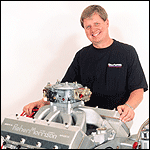 By Darin Morgan, Reher-Morrison Racing Engines
By Darin Morgan, Reher-Morrison Racing Engines
DARIN MORGAN, author of this issue’s Technically Speaking column, is in charge of cylinder head research and development at Reher-Morrison Racing Engines.
“Comparing the Space Shuttle to a racing engine may seem like a leap, but in fact the underlying variables in an engine combination are equally mind-boggling.”
With four national events in four weeks, including two round trips to Maple Grove Raceway, David Reher has been spending more time sitting on airplanes than on writing his column for National DRAGSTER. David asked me to pinch hit for him in this issue, and since my subject is computer simulation, you might think of this as a simulated David Reher article.
Engine simulation software is a hot topic in the automotive industry. Sophisticated programs such as WAVE and MANDY cost millions of dollars, which limits their customer base to auto manufacturers and Formula 1 teams. For the rest of us, there are engine simulation programs with prices that range from less than $100 to several thousand dollars.
I admit that I’m addicted to engine simulation software. I’ve played with numerous programs, and I’ve spent hours running “what if?” scenarios. But as a professional engine builder, I also understand the limitations of these programs. Unfortunately, some racers don’t.
In my conversations with simulation software designers and code writers, I’ve learned that these programs were never intended to design an entire engine. Rather, their primary objective is to note specific trends of individual changes. In other words, a program can tell you with reasonable accuracy what the likely result will be if you change the bore, stroke or runner length in a Corvette LS1 engine. It can’t tell you how to build a Quick 16 engine from scratch.
My specialty at Reher-Morrison Racing Engines is cylinder head development. I’m frequently asked about equations or formulas that can determine specific engine design criteria. Customers want to know how to calculate the perfect port volume for an engine, how to select the ideal intake manifold, or how to determine the optimum valve diameter for a runner. They want a magic formula that explains how a racing engine works – but such a shortcut simply doesn’t exist.
Consider the Space Shuttle. It’s just an airplane with rocket motors, right? But when you look into the details of launching, flying and recovering the Shuttle, it becomes apparent that this is a task of mind-boggling complexity. The variables are almost infinite.
Comparing the Space Shuttle to a racing engine may seem like a leap, but in fact the underlying variables in an engine combination are equally mind-boggling. If you don’t understand what these variables actually do, it’s tempting to plug numbers into a simulation program until you get the results you want. One likely consequence of this approach is to design an engine that’s not applicable in the real world.
Here’s an example. Recently a racer questioned me about all of the components in one of our Super Series bracket racing engines. I gave him the information he requested, and he modeled the engine with a simulation program. His results were fairly accurate, with an error of about 2.5 percent (20 horsepower), which I thought was reasonable. But the software stated that if the exhaust duration were increased 10 degrees, the engine would gain 25 additional horsepower. I just wish it were that easy!
We’ve built and dyno tested dozens of these engines. They’ve logged thousands of runs on drag strips. Now a customer tells us that we left 25 horsepower on the table. But what the simulation software didn’t allow him to do was input the discharge coefficient of the exhaust port. In other words, the program didn’t “know” the design specifics of the exhaust system. It based its calculations on simple airflow, and therefore didn’t have enough information to generate a realistic answer.
You still need experience and knowledge to get it right. The more complicated the software, the more essential this real-world database becomes. When dealing with ultra-high performance engines, the details become so subtle that no software can simulate them. In a high-end racing engine, a tiny change in the approach to the valve seat or the contour of a piston dome can produce a measurable difference in performance on the dyno and on the drag strip. Even Ferrari, with its whiz-bang Formula 1 simulation software, still has to build, test and validate any change in hardware before taking it to a race.
It’s a mistake to put blind faith in a computer program. Some programs are certainly more accurate in their predictions than others, but they all have shortcomings. Building an engine on a computer screen is no substitute for bolting together the parts and running it down a track. To my knowledge, a virtual engine has never won an NHRA national event.
 By David Reher, Reher-Morrison Racing Engines
By David Reher, Reher-Morrison Racing Engines

 By Darin Morgan, Reher-Morrison Racing Engines
By Darin Morgan, Reher-Morrison Racing Engines